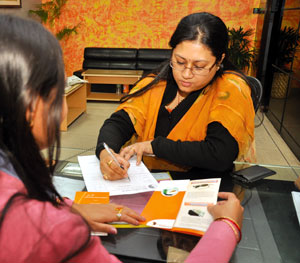 BIKRAM RAI SAFE AND SURE: An insurance agent books a client at an insurance company in Kathmandu on Wednesday. |
When the Unity Life International scandal was uncovered last year, the trust on the financial sector was severely dampened. Insurance companies in particular had a difficult time proving their credibility to their clients again. However, in the last fiscal year 768,241 life policies were sold, up by seven per cent from 718,613 policies in the previous year. The market is slowly catching up, and the players are positive about the future of the industry.
"In comparison to South Asian countries, other than India, our life insurance sector has shown growth," explains Prakash Khanal deputy director at the Insurance Board. "The stakeholders are moving in the right direction for the progress of this sector".
Life insurance began in Nepal with the state-owned National Insurance Corporation of Nepal in the early 1970s and private players entered the market only about a decade ago. There are now nine life insurance companies, with presence in 68 districts. The biggest players are National Life Insurance Company, Prime Life Insurance and Life Insurance Company (Nepal). A total premium of Rs 10.44 billion was collected by insurance companies in the last fiscal year. However, only eight per cent of the country's population is insured.
"The industry is in its nascent stage, which means there is a lot of opportunity," says P R Mishra, CEO of Life Insurance Corporation (Nepal). "We are still in the first stage of communicating and raising awareness about insurance."
Insurance companies say, there is still a lack of awareness about the importance of insurance and many are focusing on advertisement campaigns. "In a country where there is no system of social security from the state, life insurance should not be just an option," Denesh Amatya, Senior Manager at Surya Life Insurance. "And with more families becoming nuclear, life insurance has become a must."
In addition to providing financial security to the family in case of accidents and loss of life, insurance is a compulsory form of saving. It also benefits the insurer in terms of tax benefits. At present there is a tax benefit of Rs 20,000, and insurance companies have been lobbying with the government to increase it to Rs 50,000.
Resta Jha, CEO of Prime Life Insurance says that life insurance is still largely a push market but people are slowing becoming more positive about it."We seem to need reminders that life is not very certain. For example, our policies sales rose after the September earthquake." The industry also received a boost after the government decided to make insurance mandatory for migrant workers.
Insurance companies are now trying to motivate customers through product diversification, offering customised schemes for working men and women and housewives. Insurers now have a larger basket of policies to choose from and can pick those that are most suited to their needs and pockets.
In order to tap into rural market, insurance companies are now designing micro-insurance products. "We have recently completed the groundwork for micro-insurance," says deputy director Prakash Khanal. "This will help extend the reach of insurance to the sector of the population that needs it most. We expect it to replicate the success of micro-finance projects."
A sector of the urban population, however, prefers to insure in companies across the border. Every year, agents from Indian insurance companies fly down to collect premiums, and this has been responsible for capital flight.
There is an asset-liability mismatch in the life insurance industry, trade sources say. With the average period of a policy at 13.75 years, the liabilities of the companies are long-term. However, the investment options open to insurance companies are mostly short-term.
Says Jha of Prime Life: "There needs to be a regulatory change that will allow us to invest in real sectors such as health and education and diversify our investment avenues. This will increase our returns and in the end our clients will benefit."
Read also:
The almighty dollar, PAAVAN MATHEMA
The fall and fall of the Nepali rupee


